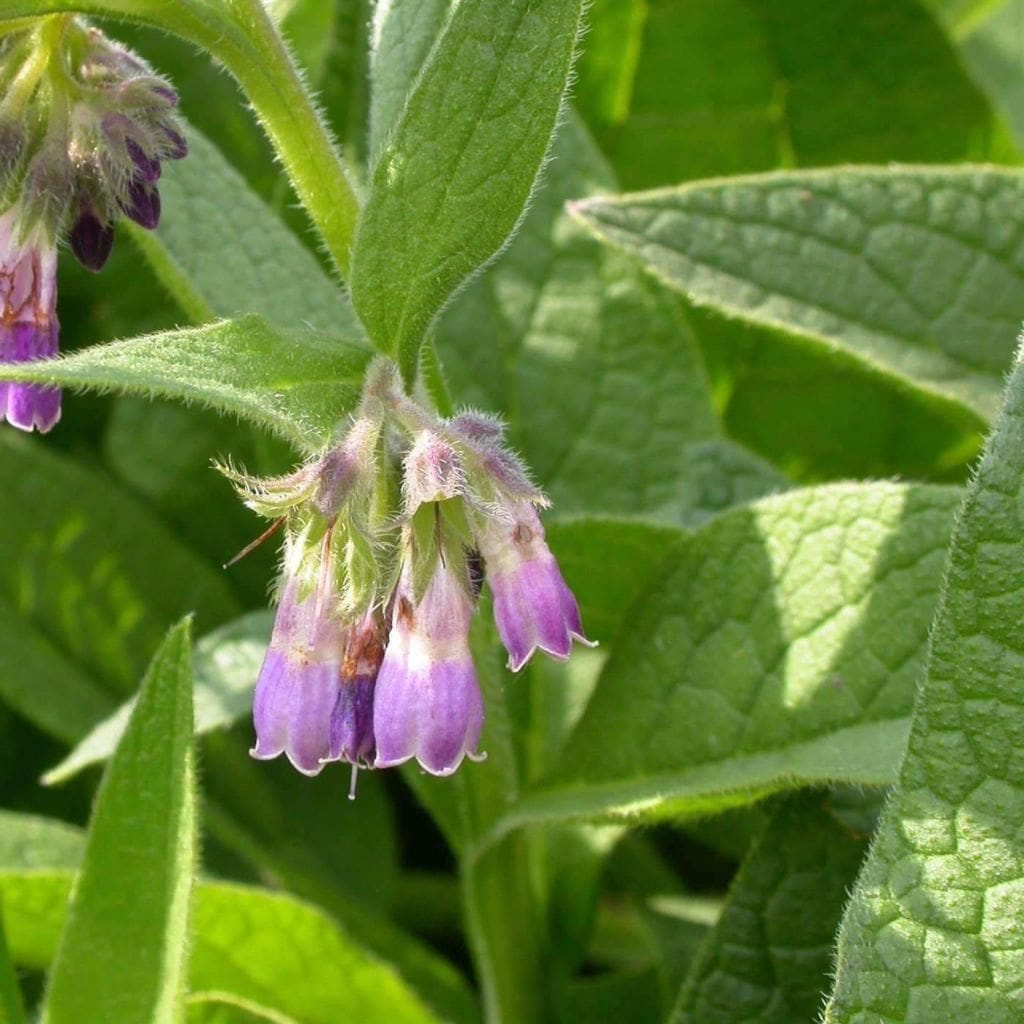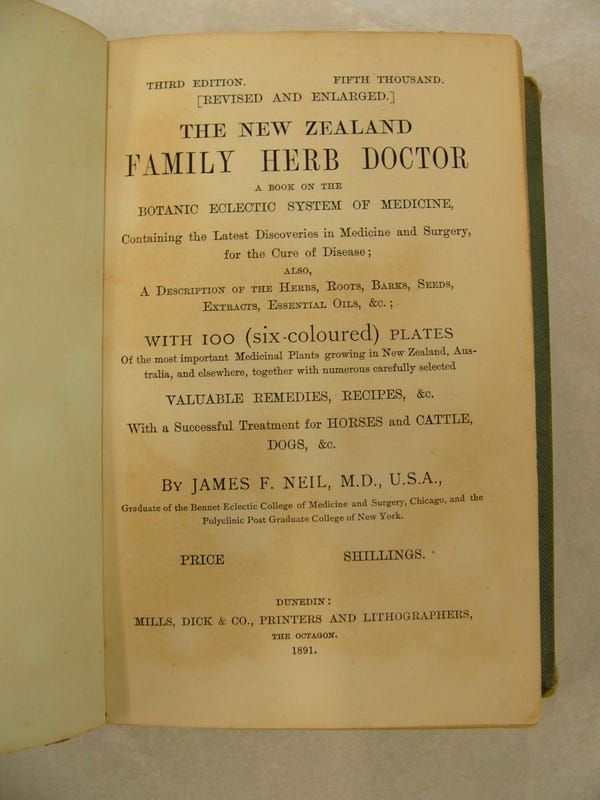Crushed Comfrey Poultice: Solved Swelling and Pain
Plus what does "The New Zealand Family Herb Doctor" (1889) have to say about comfrey?

[Disclaimer: this is my experience. It may not be yours or anyone else’s. If you plan on trying comfrey for any medical purpose ignore these ramblings. I’m very confident in my ability to research. But only for me. Do your own.]
A quick few notes from the death-cult vault. Comfrey application events described were done in 2018.
Poisoning was diagnosed as multiple sclerosis.1
One of the medical worlds‘ solutions (ahem ahem) was hardcore IV steroids. As the lovely and moral Bill Gates might say “shot straight into the vein.” Again and again.
Which resulted in a double pulmonary embolism (DPE), the clotting occurred in the upper left thigh.2
Which resulted in massively swollen left leg, below the
kneehip.3 Thigh, calf and foot etc.Which hurt like hell and lasted for years.
I suspected the swelling was the result of muck build up in the leg.
I discovered comfrey had among other wonderful medical applications the ability to extract poisons and muck etc.4
So I grabbed a leaf, crushed it, and put it on the sorest part of my leg (roughly the red box area in the image below). Poultice-like. Held in place by very loose bandages. An area of sharp pain ~2cm diameter. The skin’s appearance was indistinguishable from the surrounding area.
It lasted about 4 hours before I had to tear it off; I’d fallen asleep, and woke perspiring heavily, feeling a strong need to remove the comfrey. Skin was still intact and everything looked fine. I felt ok a few minutes after comfrey removed.
Continued this process every day for about a week. Made sure I didn’t fall asleep. Only kept comfrey on for 2 or 3 hours each day. No repeat of sweats or discomfort from comfrey.
A rather nasty ‘puss-head’ formed on the spot over this period, about 5mm diameter. Looked large.
After a week the ‘head’ was accidentally knocked off, so I decided to ‘evacuate’ the muck. Details not necessary but it was painful to do and produced a seemly endless amount of material. Had to repeat this process each day for about a week before I was satisfied the wound was empty.
A week or so later (i.e. ~2 weeks after starting to evacuate the muck) the swelling was gone, the pain caused by the swelling was gone, and I could put a shoe on!!
There are many good sources for medical applications of comfrey and its historic uses. Here’s one not many will have come across.
The New Zealand Family Herb Doctor (1889)
Written by James F. Neil of Dunedin, it was reprinted in 1980 (Capper Press; 1000 copies). He had something to say about comfrey.5


All quotes from Neil, J.F., The New Zealand Family Herb Doctor, Mills, Dick & Co., Dunedin (1889) reprinted Capper Press (1980).
Under the Demulcents section (“…As poultices and lotions they are also good.“ p65):
Comfrey Root (Symphytum officinalis) — p68
This root is a native of Europe, but is now found in most civilised lands. It has long been held in high esteem as a demulcent. The early Britons called it Knit-Bone. The root was washed, scraped, and mashed, and applied in the form of a poultice over the broken limb, where it not only assisted the healing process, but hardening, it formed a splint. Dr. Skelton strongly recommended it as a poultice in the rupture of young children, applied over the part.Of late years we have grown our own stock of this valuable root; it will be seen among our coloured lithographs. The Comfrey is cultivated by herbalists and used for making cough syrups and demulcent drinks. As a remedy for bleeding from the internal organs, it is affirmed that it will heal inward wounds better than any other agent yet discovered.
It is a good ingredient in consumptive mixtures, also for leucorrhoea or whites*. Dr. Fox recommends a syrup of it for this purpose, prepared thus:
Take two ounces of the fresh root, wash and slice it; one ounce each of white pond lily root, stinking arrach, cudweed, and ginger root.
Boil the whole gently in two quarts of water for half an hour, pour the whole hot upon two nutmegs powdered fine, half a teaspoon of cayenne pepper, and half a pound of loaf sugar.
A wineglassful of this four times a day, if persevered in, will cure this troublesome and weakening complaint. The decoction is two ounces of green or one ounce of dry to one pint. A wineglass four times a day; it may be sweetened.
* leucorrhoea or whites is discussed further on pages 445/6.
Under the Abbreviations and Properties Explained section (p130).
Comfrey Root (Symphytum officinalis) p136
Pec. = pectoral—useful in diseases of lungs and chest (p131)
Dem. = Demulcent—softening, and sheathing from the action of acrid substances (p130)
Ton. = Tonic—permanently strengthening (p131)Valuable in dysentery, gleets, diseases of the bladder, kidneys, and bowels. Cr-Dec. and Syr.; or pulv. in substance, in milk.
Under the Poultices section (p233).
Comfrey Poultice (p235)
Comfrey root (in powder) — sufficient.
Mix with boiling water to a proper consistency, and apply immediately to the part affected, or between cloths.This is an excellent poultice in cases of hernia or rupture, applied immediately after the protrusion is returned. If changed as necessary, kept in position, and rest enforced, it assists most readily to repair the break or loss of continuity.
It was known by the synonym “Knit-bone” by our Saxon forefathers, from the fact of its power of healing or uniting broken bones. Our modern scientific and over-wise modern physicians smile at this simplicity, but if they were to reflect, they might see at once that a broken bone depends for its re-union upon the integrity of the periosteum. It is because of its power in subduing the inflammatory condition of the membrane that the bone and broken part are so readily repaired.
Under the Internal Inflammations section (p329), Inflammation of the Lining of the Chest - pleurisy (p333). Comfrey root is used as an ingredient in a convalescent tonic after “the severe symptoms have passed” achieved using medicine previously taken (as recommended, pp333, 334).
Comfrey root gets a few further mentions, as an ingredient in decoction remedies for:
internal bleeding,
chest infections; asthma, consumption (phthisis),
atrophy or wasting of the body (p476)
Comfrey leaf, which I used above, does not appear to get a mention.
I intend to do a post on James Neil and his history - for example he has a dig at Pasteur when discussing rabies (p403). And I hope to reproduce the entire contents of this book; 512 pages. Multiple posts over time. We’ll see.
See also:
For me MS doesn’t exist as I was told. Everything that manifested were symptoms of poisoning. See earlier posts.
I was told this by a neurologist, who, speaking in tongues, when I told him I’d had a DPE said “had you just been given IV steroids?” Which I had. There’s plenty of ways to say something without saying it.
A nice Christchurch hospital memory of this ‘discovery’.
I coughed blood all night. The nurses ignored it - and it was obvious; they must have seen it. My wife came in in the morning and discovered the blood. Finally some action. A stent (is that the right word? it was intended to break up clots) in a heart inlet vein — I think it had to go through the heart to get in place. Put in through the neck using one hell of a large ‘microscope’. The chap (I forget what his title was) who inserted it had originally trained as a Chemical Engineer. We had a great chat. I was left with the very strong impression he was very skeptical about the ‘knowledge‘ of his medically trained colleagues. But I don’t want to put words in his mouth.
Jack Hylton - Happy Days Are Here Again (1930)
Addendum: should have written hip. Perfect in my next lifetime.
“wonderful medical applications“
I had it for gardening.
An original copy of The New Zealand Family Herb Doctor (1889) sold on TradeMe in Oct. 2024 for $300.
Gold and myrrh powder appear. Still looking for frankincense. Turpentine has many mentions. It isn’t specific but the assumption is it is pine/gum turpentine only. Mineral turpentine - from petroleum - is unlikely to have been available in 1889.






I fixed my ducks broken leg (from a fox bite) using broken comfrey wrapped around tied in place and left for a couple of days. Before that I had used benzene but the leg started to go off.
Excellent stuff. Seems to be harder to find too. It used to be growing everywhere. I'm nursing a long a small cutting in my garden atm. I first heard of it via the BBC gardening program... they used it for their tomato food. Soak the leaves in a bucket of water a long time til they're smelly as then dilute & feed to your plants.